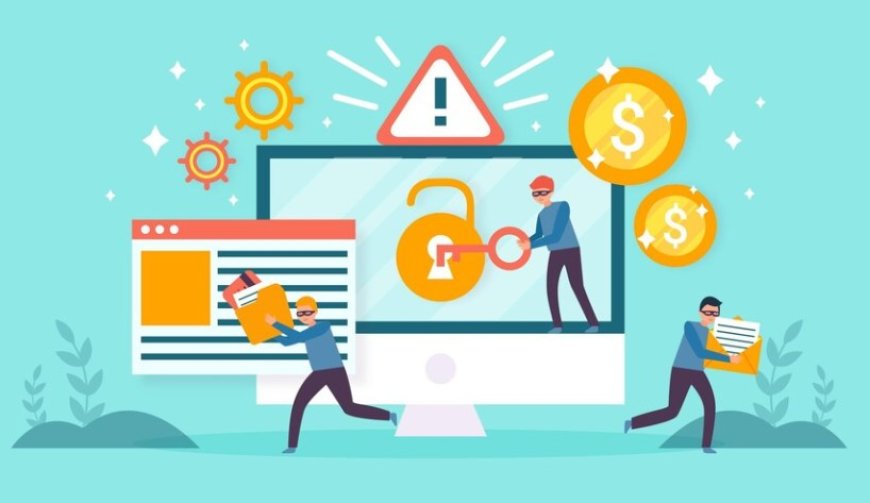Explaining Common Cyber Threats
Explore common cyber threats and stay informed about online security risks. Learn how to protect yourself from cyber attacks with this comprehensive guide.

The introduction provides an essential overview of the document's purpose and the significance of understanding common cyber threats. It highlights the critical role cybersecurity plays in protecting individuals and organizations from various online risks. The introduction serves as a gateway to the document's exploration of different cyber threats and emphasizes the importance of proactive measures to mitigate these risks effectively.
Cyber threats
Cyber threats encompass a broad category of malicious activities in the digital realm that pose risks to computer systems, networks, and data. These threats involve deliberate actions by individuals or groups with the intent to compromise the confidentiality, integrity, or availability of digital resources. Cyber threats can manifest in various forms, including malware, phishing attacks, hacking attempts, and insider misconduct. They exploit vulnerabilities in software, hardware, or human behavior to gain unauthorized access, steal sensitive information, disrupt services, or cause financial and reputational harm. Understanding the definition of cyber threats is fundamental to developing effective strategies for cybersecurity and safeguarding digital assets.
Types of Common Cyber Threats
Malware: Malware, short for malicious software, encompasses various threats, including viruses, Trojans, and ransomware. Viruses attach themselves to legitimate programs and replicate, causing damage. Trojans disguise as legitimate software but carry malicious payloads. Ransomware encrypts files, demanding a ransom for decryption.
Phishing Attacks: Phishing is a deceptive tactic, with variations like email phishing, where attackers use fraudulent emails to trick recipients into revealing sensitive information. Spear phishing targets specific individuals or organizations, often with personalized, convincing messages.
DDoS Attacks: Distributed Denial of Service (DDoS) attacks flood a target's network or server with traffic, overwhelming it and causing service disruption. These attacks can be orchestrated from multiple sources.
Insider Threats: Insider threats involve individuals within an organization exploiting their access to harm the company. Threats can be either malicious or unintentional, making them challenging to detect.
Social Engineering: Social engineering manipulates people into revealing confidential information or performing actions against their best interests. Attackers often exploit psychological and emotional factors.
Password Attacks: Password attacks aim to gain unauthorized access by guessing or stealing passwords. Techniques include brute force attacks and dictionary attacks. Strong password policies and encryption are crucial defenses.
Zero-Day Exploits: Zero-day exploits target vulnerabilities in software that developers haven't patched yet. Attackers exploit these vulnerabilities to gain unauthorized access or compromise systems.
Man-in-the-Middle Attacks: In Man-in-the-Middle (MitM) attacks, adversaries intercept and alter communication between two parties without their knowledge. This can lead to data theft or manipulation of information.
Understanding these common cyber threats is essential for effective cybersecurity measures and protection against evolving risks.
Impact and Consequences
Data breaches can have severe repercussions for individuals and organizations. When sensitive information, such as customer data or trade secrets, falls into the wrong hands, it can lead to identity theft, fraud, and the exposure of confidential information. Data breaches often result in financial losses, damage to reputation, and legal liabilities.
Cyber threats can cause significant financial losses. These losses may stem from direct theft of funds, costs associated with mitigating the breach, and potential lawsuits or fines. Furthermore, the downtime caused by cyberattacks can lead to a loss of revenue and productivity, affecting an organization's bottom line.
A damaged reputation can be one of the most enduring consequences of cyber threats. When customers and stakeholders lose trust in an organization's ability to protect their data, they may take their business elsewhere. Reputation damage can result in long-term financial and operational challenges.
Cybersecurity breaches often trigger legal and regulatory consequences. Data protection laws, such as GDPR in Europe or HIPAA in the United States, mandate strict standards for handling personal and sensitive data. Failure to comply can lead to fines and legal actions, which can further harm an organization's financial standing and reputation. Legal consequences may also involve civil or criminal litigation against the perpetrators of cybercrimes.
Common Targets
Cyber threats cast a wide net, impacting various sectors.
Individuals are frequently targeted through phishing scams, malware-laden emails, or social engineering tactics. These attacks aim to steal personal information, financial data, or compromise privacy.
Businesses face a constant barrage of cyber threats. Ranging from ransomware attacks to sophisticated espionage, cybercriminals seek to exploit vulnerabilities for financial gain or to disrupt operations.
Government organizations are prime targets due to the sensitive nature of the information they hold. Espionage, data breaches, and political manipulation are common threats faced by government entities.
Critical infrastructure such as power grids, transportation systems, and healthcare facilities, are of paramount importance. Targeting them can have devastating consequences, making them attractive targets for cybercriminals seeking to create chaos or gain leverage. Protecting these sectors is vital for the stability of societies and economies worldwide.
Preventive Measures
Cybersecurity Best Practices
Implementing cybersecurity best practices is fundamental in defending against common cyber threats. These practices include robust password policies, least privilege access, and the principle of least privilege to limit exposure to potential attacks. Regular security audits and risk assessments also fall under this category.
Antivirus and Antimalware Tools
Deploying antivirus and antimalware solutions is crucial to detect and neutralize known malware threats. These tools help prevent malicious code from infiltrating systems and compromising data. Regularly updating these tools ensures they stay effective against emerging threats.
Employee Training and Awareness
The human factor is often the weakest link in cybersecurity. Conducting employee training and awareness programs educates staff on recognizing and responding to potential threats like phishing emails, social engineering attempts, and suspicious behavior. Educated employees play a pivotal role in the organization's overall security posture.
Regular Software Updates
Keeping software up to date is essential for addressing known vulnerabilities. Software vendors release updates and patches to fix security flaws and enhance system resilience. Delayed or neglected updates can leave systems exposed to exploitation. Automated patch management systems can help streamline this process.
Network Security Measures
Employing robust network security measures, such as firewalls, intrusion detection systems, and intrusion prevention systems, helps safeguard against unauthorized access and network-based attacks. Implementing strong access controls, network segmentation, and encryption also contribute to a robust defense against cyber threats. Regular network monitoring and analysis are crucial to identifying and mitigating potential risks in real-time.
Incident Response
Detection and Alerting
In the event of a cyber threat, the first step in incident response is detection and alerting. This phase involves the identification of unusual or suspicious activities within the network or system. Various security tools and monitoring systems are employed to detect potential threats, such as intrusion detection systems (IDS) and security information and event management (SIEM) solutions. When an incident is detected, alerts are generated to notify the incident response team.
Containment and Eradication
Once an incident is detected, it is crucial to contain the threat and prevent it from spreading further. Containment strategies are designed to isolate affected systems or networks to minimize the impact. Simultaneously, the incident response team works to eradicate the threat by removing malware, closing vulnerabilities, or eliminating unauthorized access points. Effective containment and eradication reduce the potential damage caused by the incident.
Recovery and Restoration
After containment and eradication efforts are successful, the focus shifts to recovery and restoration. This phase involves restoring affected systems to normal operation while ensuring their security. It may also include data recovery and backup restoration to minimize data loss. This step is critical for business continuity and returning to normalcy after an incident.
Post-Incident Analysis
The final phase of incident response involves a thorough post-incident analysis. This step is essential for learning from the incident and improving future cybersecurity measures. It includes a detailed examination of the incident's root causes, the tactics used by the attacker, vulnerabilities exploited, and the effectiveness of the incident response plan. Lessons learned from this analysis inform updates to security policies, procedures, and the development of more robust defenses against similar threats in the future.
A comprehensive overview of common cyber threats and the critical need for awareness and preparedness in the digital age. We've discussed various types of threats, from malware and phishing attacks to DDoS assaults and insider threats, highlighting their methods, consequences, and prevention strategies. It is essential to recap the significance of staying vigilant in the face of evolving threats, emphasizing that cybersecurity is an ongoing process. By adopting proactive cybersecurity measures, individuals, businesses, and governments can mitigate risks, protect sensitive information, and contribute to a safer digital environment for all. It is our collective responsibility to remain informed and proactive in the fight against cyber threats to ensure a more secure and resilient future online.



























































